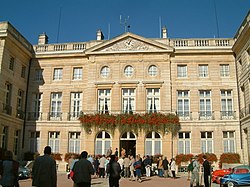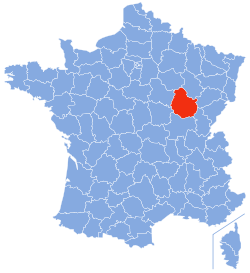Côte-d'Or
Côte-d'Or (literally, "Slope of Gold", "Golden Slope") is a department in the eastern France. It is one of the 83 first French departments made during the French revolution and one of the eight departments of the Bourgogne-Franche-Comté region.
 | |
 Location of Côte-d’Or in France | |
| Coordinates: 47°25′N 04°50′E / 47.417°N 4.833°ECoordinates: 47°25′N 04°50′E / 47.417°N 4.833°E | |
| Country | France |
| Region | Bourgogne-Franche-Comté |
| Département | 4 March 1790 |
| Prefecture | Dijon |
| Subprefectures | Beaune, Montbard |
| Government | |
| • President | François Sauvadet[1] |
| Area | |
| • Total | 8,763.2 km2 (3,383.5 sq mi) |
| Population (2014)[3] | |
| • Total | 531,380 |
| • Density | 60.6377/km2 (157.0508/sq mi) |
| Time zone | UTC+1 (CET) |
| • Summer (DST) | UTC+2 (CEST) |
| ISO 3166 code | FR-21 |
| Arrondissements | 3 |
| Cantons | 23 |
| Communes | 704 |
| Website | http://www.cotedor.fr |
Its prefecture (capital) is the city of Dijon. The inhabitants of the department are called Costaloriens (women:Costaloriennes) or Côte-d'Oriens (women:Côte d'Oriennes).[4]
History
Côte-d'Or is one of the original 83 departments created during the French Revolution on 4 March 1790. It was formed from part of the old province of Burgundy. It was divided in seven districts: Arnay-le-Duc, Beaune, Châtillon-sur-Seine, Dijon, Is-sur-Tille, Saint-Jean-de-Losne and Semur-en-Auxois.
In 1800, with the creation of the arrondissements in France, the seven districts were changed into four arrondissements: Dijon, Beaune, Châtillon-sur-Seine and Semur-en-Auxois.[5]
After the Battle of Waterloo (18 June 1815), the department was occupied by the Austrian army from June 1815 to November 1818.
In 1926, the arrondissement of Montbard was made with the arrondissements of Châtillon-sur-Seine and Semur-en-Auxois.[5]
Origin of name
Côte-d'Or is the only French department who was not named after a geographical feature: a river, a mountain, and so on. The name was chosen by Charles-André-Rémy Arnoult, member of the National Constituent Assembly of 1789, who suggested the name, inspired by the golden hue that took the vineyards of the region in the autumn.[6]
The French word côte means, in this case, a slope that geologists usually name with the Spanish word cuesta.
Geography
Côte-d'Or is part of the region of Bourgogne-Franche-Comté. The department borders with 7 departments that are part of 2 regions:
- Grand Est region
- Aube (north)
- Haute-Marne (northeast)
- Bourgogne-Franche-Comté region
- Haute-Saône (east)
- Jura (southeast)
- Saône-et-Loire (south)
- Nièvre (southwest)
- Yonne (west)
The department has an area of 8,763.2 km2 (3,383 sq mi).[2] The highest point of the department is Mont de Gien (47°07′37″N 4°07′06″E / 47.12694°N 4.11833°E), 721 m (2,365 ft) high;[7] it is in the commune Ménessaire. The lowest point of the department, 174 m (571 ft) high, is where the river Saône leaves the department, in the commune Chivres.
A chain of hills called the Plateau de Langres runs from north-east to south-west through the department to the north of Dijon and continues south-westwards as the Côte d'Or escarpment, which takes its name from that of the department (without the hyphen). It is the south-east facing slope of this escarpment which is the site of the celebrated Burgundy vineyards. To the south-east of the plateau and escarpment, the department lies in the broad valley of the middle section of the river Saône.
Rivers
The main rivers of Côte-d'Or are:
- The Seine, with its source in the southern end of the Plateau de Langres, in the commune Source-Seine.[8]
- The Saône, an important tributary of the Rhône. It flows through several communes of the Côte-d'Or department and some of the tributaries are Vingeanne, Tille, Bèze and Ouche.
- The Arroux is a right tributary of the Loire.
Climate
The Köppen climate classification type for the climate at Dijon is an "Oceanic climate" (also known as Maritime Temperate climate) and of the subtype "Cfb".[9]
The average temperature for the year in Dijon is 10.6 °C (51.1 °F). The warmest month, on average, is July with an average temperature of 19.4 °C (66.9 °F). The coolest month, on average is January, with an average temperature of 1.7 °C (35.1 °F).
The average amount of precipitation for the year in Dijon is 698.5 mm (27.50 in). The month with the most precipitation on average is October with 73.7 mm (2.90 in) of precipitation. The month with the least precipitation on average is February with an average of 40.6 mm (1.60 in).[9]
In the Plateau de Langres, winters are long and cold with frequent frosts.
Administration
The department is managed by the Departmental Council of Côte-d'Or in Dijon. Côte-d'Or is part of the region of Bourgogne-Franche-Comté.
Administrative divisions
There are 3 arrondissements (districts), 23 cantons and 704 communes (municipalities) in Côte-d'Or.[10]
| INSEE code |
Arrondissement | Capital | Population[11] (2014) |
Area[12] (km²) |
Density (Inh./km²) |
Communes |
|---|---|---|---|---|---|---|
| 211 | Beaune | Beaune | 97,107 | 2,118.3 | 45.8 | 223 |
| 212 | Dijon | Dijon | 373,574 | 3,049.0 | 122.5 | 228 |
| 213 | Montbard | Montbard | 60,699 | 3,595.9 | 16.9 | 253 |
The following is a list of the 23 cantons of the Côte-d'Or department (with their INSEE codes), following the French canton reorganisation which came into effect in March 2015:[13]
- Arnay-le-Duc (2101)
- Auxonne (2102)
- Beaune (2103)
- Brazey-en-Plaine (2104)
- Châtillon-sur-Seine (2105)
- Chenôve (2106)
- Chevigny-Saint-Sauveur (2107)
- Dijon-1 (2108)
- Dijon-2 (2109)
- Dijon-3 (2110)
- Dijon-4 (2111)
- Dijon-5 (2112)
- Dijon-6 (2113)
- Fontaine-lès-Dijon (2114)
- Genlis (2115)
- Is-sur-Tille (2116)
- Ladoix-Serrigny (2117)
- Longvic (2118)
- Montbard (2119)
- Nuits-Saint-Georges (2120)
- Saint-Apollinaire (2121)
- Semur-en-Auxois (2122)
- Talant (2123)
Demographics
Côte d'Or has a population, in 2014, of 531,380,[3] for a population density of 60.6 inhabitants/km2. The arrondissement of Dijon, with 373,574 inhabitants, is by far the one with more inhabitants. The other two, Beaune and Montbard, have respectively 97,107 and 60,699 inhabitants.[11]
Evolution of the population in Côte-d'Or

The main cities in the department are:
| City | Population[11] (2014) |
Arrondissement |
|---|---|---|
| Dijon | 153,668 | Dijon |
| Beaune | 21,579 | Beaune |
| Chenôve | 14,165 | Dijon |
| Talant | 11,346 | Dijon |
| Chevigny-Saint-Sauveur | 11,097 | Dijon |
| Quetigny | 9,675 | Dijon |
| Fontaine-lès-Dijon | 8,968 | Dijon |
| Longvic | 8,959 | Dijon |
| Auxonne | 7,835 | Dijon |
| Saint-Apollinaire | 7,353 | Dijon |
Gallery
Vineyards in Côte-d'Or
Côte-d'Or Media
Reenactment of the siege of Alesia in Alise-Sainte-Reine
Related pages
References
- ↑ "Le Président du Conseil Départemental" (in French). Côte-d'Or - Le Départment. Archived from the original on 3 November 2016. Retrieved 4 November 2016.
{{cite web}}: CS1 maint: unrecognized language (link) - ↑ 2.0 2.1 "Département de la Côte-d'Or (21)". Comparateur de territoire (in French). Institut national de la statistique et des études économiques - INSEE. Retrieved 6 June 2017.
{{cite web}}: CS1 maint: unrecognized language (link) - ↑ 3.0 3.1 "Populations légales 2014: Recensement de la population - Régions, départements, arrondissements, cantons et communes" (in French). Institut national de la statistique et des études économiques - INSEE. Retrieved 6 June 2017.
{{cite web}}: CS1 maint: unrecognized language (link) - ↑ "Côte-d'Or (21)" (in French). habitants.fr. Retrieved 17 June 2014.
{{cite web}}: CS1 maint: unrecognized language (link) - ↑ 5.0 5.1 "Historique de la Côte-d'Or". Le SPLAF (in French). Retrieved 17 June 2014.
{{cite web}}: CS1 maint: unrecognized language (link) - ↑ "Côte-d'Or "la bien nommée"" (in French). Conseil General - Côte-d'Or. Archived from the original on 1 October 2010. Retrieved 7 October 2013.
{{cite web}}: CS1 maint: unrecognized language (link) - ↑ "Mont de Gien, France". Peakbagger.com. Retrieved 4 November 2016.
- ↑ "A l'origine". Site des sources de la Seine et du village de Source Seine (in French). Retrieved 7 October 2013.
{{cite web}}: CS1 maint: unrecognized language (link) - ↑ 9.0 9.1 "Dijon, France - Köppen Climate Classification". Weatherbase. Retrieved 8 October 2013.
- ↑ "Département de la Côte-d'Or (21)". Géographie administrative et d'étude (in French). Institut national de la statistique et des études économiques - INSEE. Retrieved 6 June 2017.
{{cite web}}: CS1 maint: unrecognized language (link) - ↑ 11.0 11.1 11.2 "Régions, départements, arrondissements, cantons et communes" (PDF). Populations légales 2014 (in French). Institut national de la statistique et des études économiques - INSEE. Retrieved 6 June 2017.
{{cite web}}: CS1 maint: unrecognized language (link) - ↑ "Département de la Côte-d'Or (21)". Comparateur de territoire (in French). Institut national de la statistique et des études économiques - INSEE. Retrieved 6 June 2017.
{{cite web}}: CS1 maint: unrecognized language (link) - ↑ "Décret n° 2014-175 du 18 février 2014 portant délimitation des cantons dans le département de la Côte-d'Or" (in French). Legifrance.gouv.fr. 18 February 2014. Retrieved 23 April 2015.
{{cite web}}: CS1 maint: unrecognized language (link)
Other websites
| Wikimedia Commons has media related to Lua error in Module:Commons_link at line 62: attempt to index field 'wikibase' (a nil value).. |
- Departmental Council website Archived 2018-06-10 at the Wayback Machine (in French)
- Prefecture website Archived 2006-02-18 at the Wayback Machine (in French)
- Pays Beaunois (in French)











